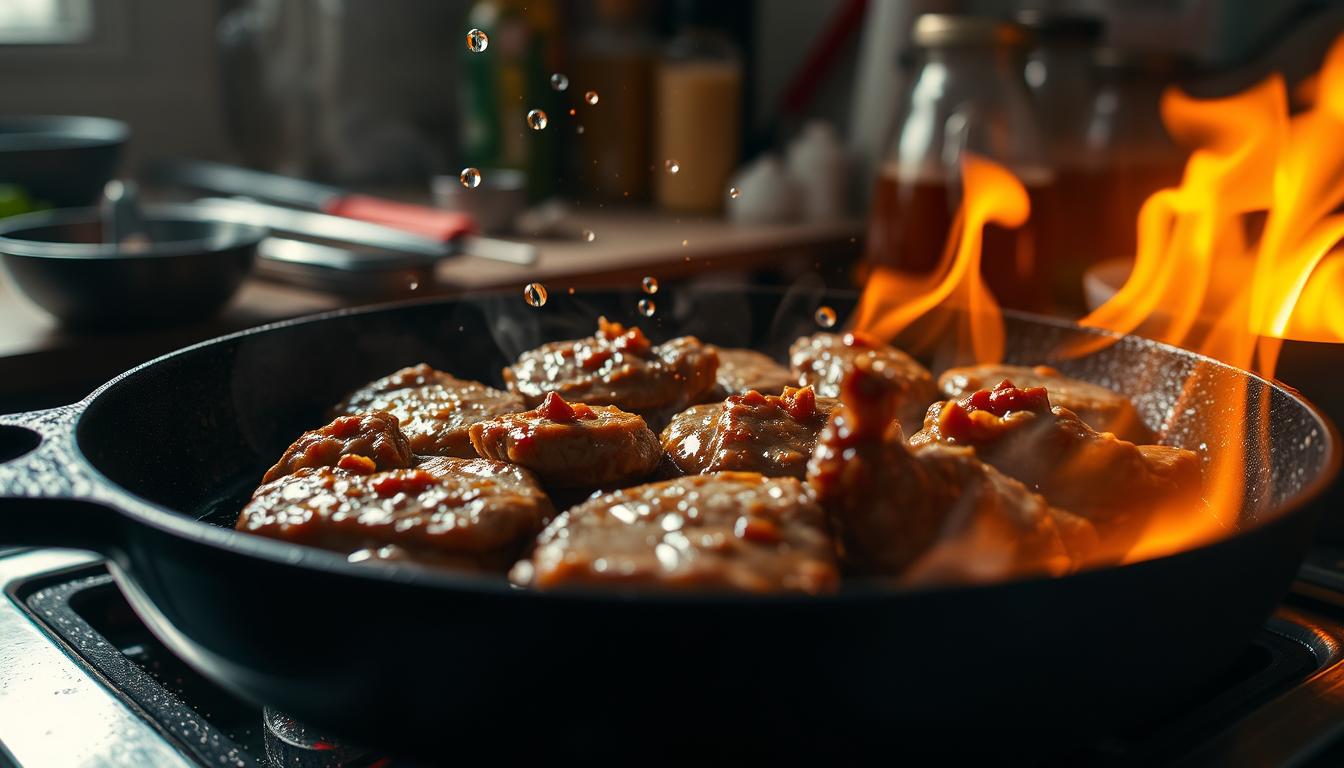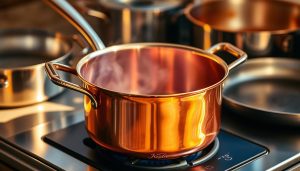83% of home cooks instinctively adjust their heat when hearing that signature ssssshhh sound, according to a recent Yale University culinary study. This audible cue does more than make your stomach growl – it reveals precise chemical reactions occurring between ingredients and cooking surfaces.
That satisfying noise signals optimal surface contact and temperature control. When proteins meet properly heated pans, moisture instantly vaporizes, creating the characteristic sizzle. This reaction ensures ideal browning while locking in flavors.
Mastering these auditory cues helps anyone improve their results. Different surfaces like cast iron versus stainless steel produce distinct sizzling patterns. Learning to interpret these sounds gives you real-time feedback about doneness levels.
Professional chefs rely on this acoustic guidance more than timers. By understanding the science behind the noise, you’ll gain confidence in managing heat levels and ingredient placement. This knowledge applies equally to searing meats and sautéing vegetables.
Key Takeaways
- Sizzling sounds indicate proper pan temperature and food-surface contact
- Different cooking surfaces create unique auditory feedback patterns
- The Maillard reaction (flavor development) coincides with peak sizzling
- Auditory cues provide better timing guidance than visual checks alone
- Controlling vaporization rates improves texture and moisture retention
The Science Behind the Sizzle
That crisp snap-hiss when ingredients meet your pan isn’t random noise—it’s a precise chemical orchestra. At 300°F or higher, water droplets instantly vaporize, creating steam bubbles that burst with audible pops. This sound confirms your cooking surface has reached the ideal temperature for proper browning.

Understanding Heat, Temperature, and Sound
Three factors drive the sizzle: surface heat, ingredient moisture, and contact area. Cast iron retains temperature better than stainless steel, producing louder, longer-lasting sizzles. Chef Thomas Keller notes:
“The first 30 seconds of cooking tell you everything—a weak sizzle means you’ve lost the thermal battle.”
This auditory feedback acts as a real-time model for gauging doneness. If the noise fades too quickly, your pan likely cooled below 250°F—the minimum threshold for the Maillard reaction.
A Closer Look at the Maillard Reaction
Named after French chemist Louis-Camille Maillard, this process transforms proteins and sugars into complex flavor compounds. It requires:
| Factor | Maillard Reaction | Slow Cooking |
|---|---|---|
| Temperature | 285-355°F | 160-200°F |
| Time | Seconds to minutes | Hours |
| Key Result | 500+ flavor compounds | Tenderized fibers |
This reaction explains why grilled meats taste fundamentally different than braised ones. Control the heat, and you control the symphony of flavors in every bite.
What Makes Food Sizzle in the Kitchen
Your cooking surface becomes a scientific instrument when you listen carefully. Compare searing chicken in a cast iron skillet versus microwaving leftovers—the former erupts with energetic pops while the latter stays eerily quiet. This stark contrast reveals fundamental principles of thermal energy transfer.

Observations and Early Models in Cooking
When you place chilled steak in a hot pan, three things happen simultaneously: surface moisture vaporizes, proteins contract, and sugars caramelize. The loud initial sizzle gradually softens as the meat’s internal temperature rises. This audio pattern helps experienced cooks gauge doneness without flipping constantly.
Microwave heating works differently—energy penetrates food uniformly rather than starting at the surface. Without concentrated heat contact, moisture escapes gradually instead of creating explosive steam bursts. Your ears get no helpful feedback about internal cooking progress.
How Ingredients and Techniques Influence the Sizzle
High-water-content foods like zucchini create dramatic initial noise that fades quickly. Marbled ribeyes maintain steady sizzling as rendered fat keeps the pan lubricated. Chef Vivian Howard explains:
“The best sears happen when ingredients meet the pan with confidence—no timid placement.”
Try this experiment: Cook shrimp and apples in identical skillets. The shellfish will hiss violently from rapid protein denaturation, while the fruit’s sugars create a quieter caramelization melody. Mastering these sound signatures helps you adjust methods for perfect results every time.
Mastering Grilling and Outdoor Cooking Techniques
Fire management separates casual grillers from outdoor cooking experts. Your ability to manipulate flames determines whether you get charred disasters or perfectly caramelized crusts. Two-zone setups transform standard grills into precision instruments.

Direct vs. Indirect Heat: A Practical Comparison
Direct grilling means placing food straight over flames. This method creates intense sizzling sounds as juices hit coals. Use it for thin cuts needing quick cooking times—think burgers or asparagus.
Indirect heat positions meat away from flames. Hot air circulates like a convection oven. This gentle way prevents burning on large roasts. Chef Aaron Franklin explains:
“Brisket demands patience—low indirect heat lets collagen break down without drying the meat.”
The Reverse Sear: Elevating Your Steak Game
This advanced technique starts with indirect cooking. Bring steaks to 225°F slowly, then finish over roaring flames. The result? Even doneness from edge to edge with a crispy exterior.
Home cooks often fear longer cooking times. But the reverse sear proves temperature control beats speed. Thick cuts develop deeper flavor while staying juicy. Pair this method with digital thermometers for foolproof results.
Master these approaches to handle any grilling challenge. Your grill becomes a versatile tool—sear scallops on direct heat while slow-roasting vegetables nearby. Adapt your way of cooking based on ingredient needs.
Sizzle Steak: Quick, Tasty, and Versatile
Weeknight dinners transform when you master this budget-friendly beef cut. Sizzle steak’s thin profile and quick cooking time make it ideal for fast meals without sacrificing flavor. Let’s explore how butchers prepare it and how you can maximize its potential.
Butchering, Slicing, and Tenderizing Explained
Butchers source this steak from the top sirloin or round – areas with dense muscle fibers. They slice it paper-thin (¼-inch) and pound it with mallets. This process breaks down connective tissues, creating tender meat ready for high-heat cooking.
Sauces and Marinades to Enhance Flavor
Lean beef benefits from bold flavor boosters. Try these options:
- Garlic-herb butter melting over freshly seared steak
- Red wine pan sauces deglazed from crispy bits
- Bright chimichurri cutting through rich flavors
Marinate for 30 minutes in soy-ginger mixtures for Asian-inspired dishes.
Integrating Sizzle Steak into Various Dishes
This versatile cut adapts to global cuisines. Roll it into braciole with Italian cheeses, or slice it for Philly cheesesteak sandwiches. Quick-cook strips work perfectly in fajitas or beef fried rice. Chef Emily Watkins notes:
“Treat it like culinary putty – it molds to any flavor profile you create.”
Air fryer preparation yields crispy edges in minutes, while grill marks add smoky depth.
Conclusion
Your kitchen now holds unlocked potential through the science of thermal dynamics. Every sizzling steak or caramelizing vegetable demonstrates controlled energy transfer in action. The Maillard reaction isn’t just chemistry—it’s your secret weapon for building complex flavors.
Mastering heat management transforms routine cooking into precision artistry. Whether searing beef cuts or monitoring grill zones, you control texture and taste through temperature adjustments. Different techniques yield distinct results—direct flames for char, indirect heat for tenderness.
Remember: Quality outcomes depend on surface contact and moisture control. Thinly sliced meats react differently than dense vegetables. Professional cooks leverage these variations, using auditory cues as real-time guides.
Equipped with this knowledge, you’re ready to experiment confidently. Apply these principles to various ingredients and cooking methods. Your next meal becomes a laboratory where science meets culinary creativity.



